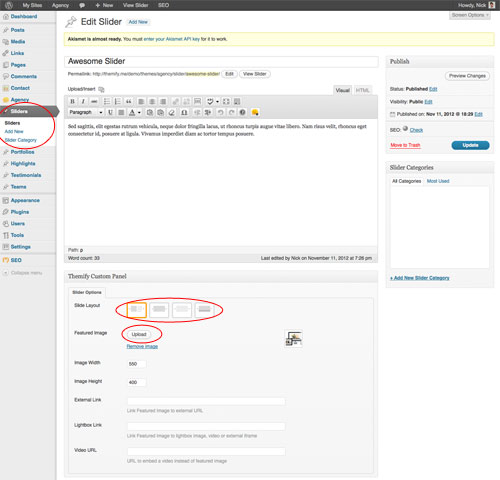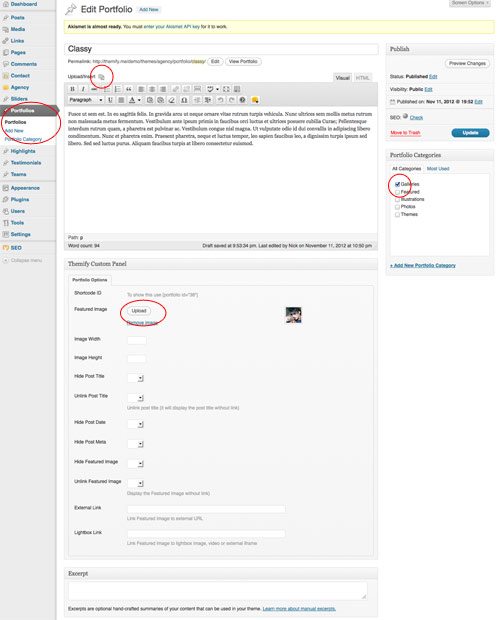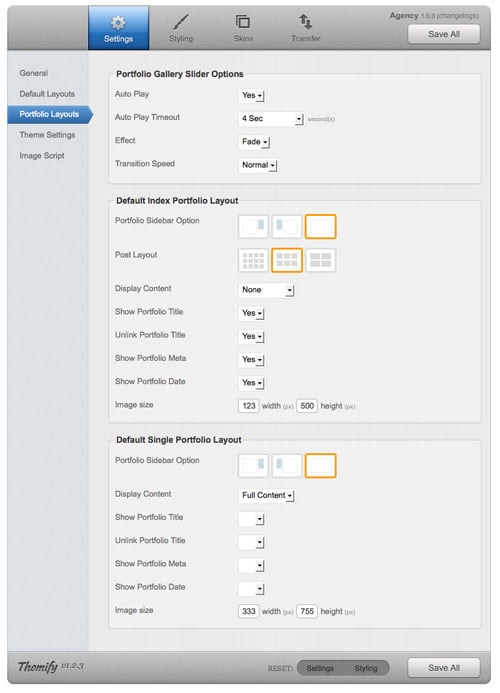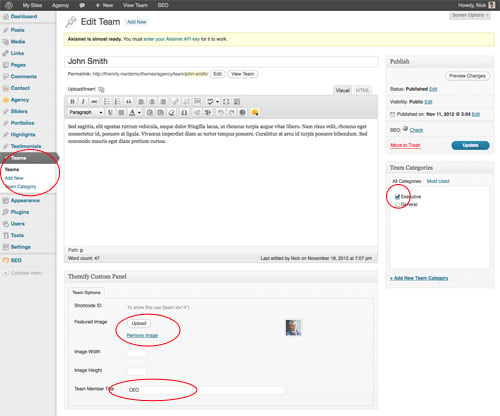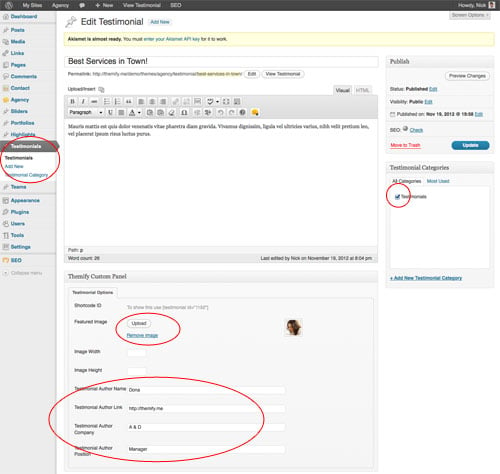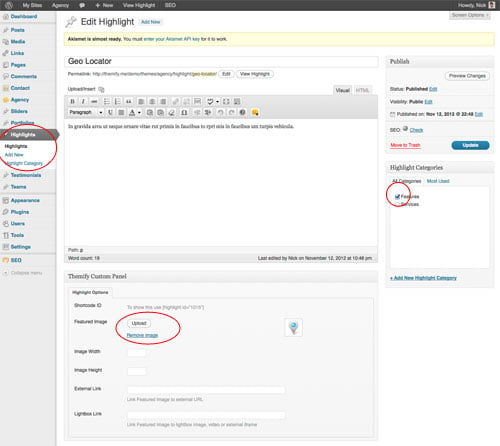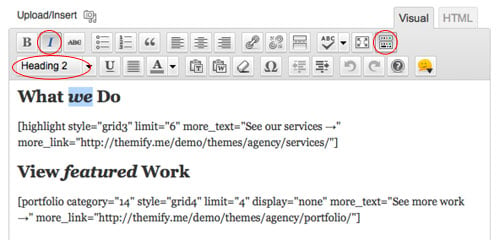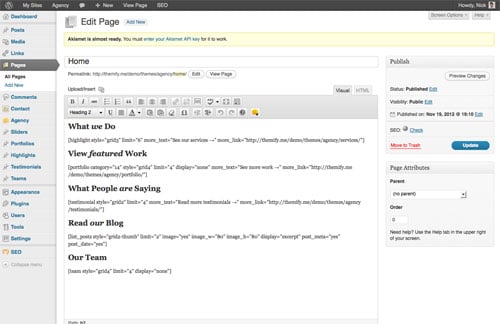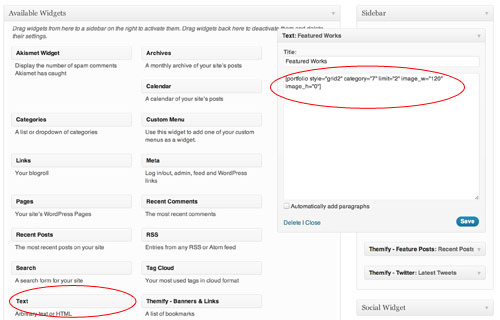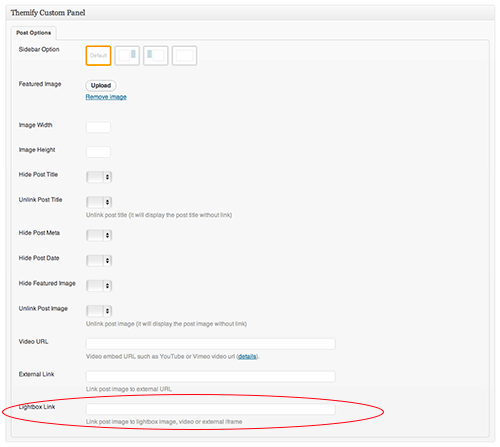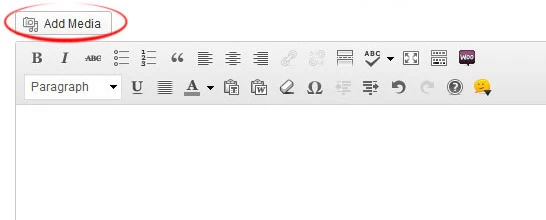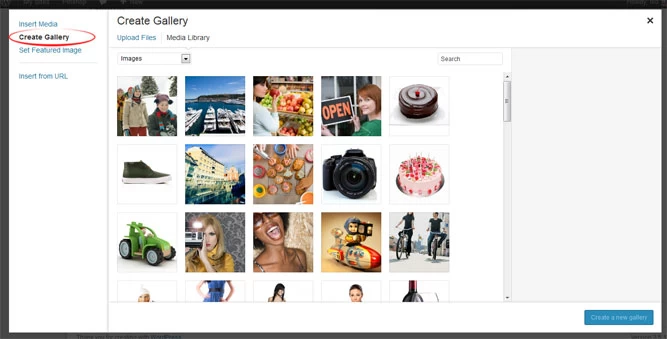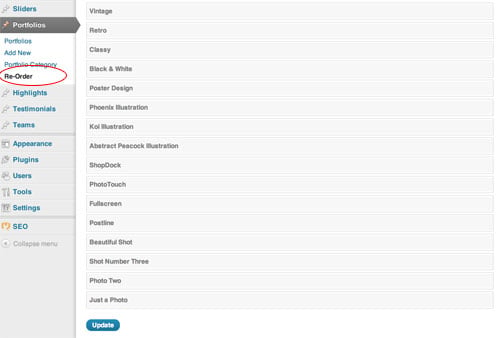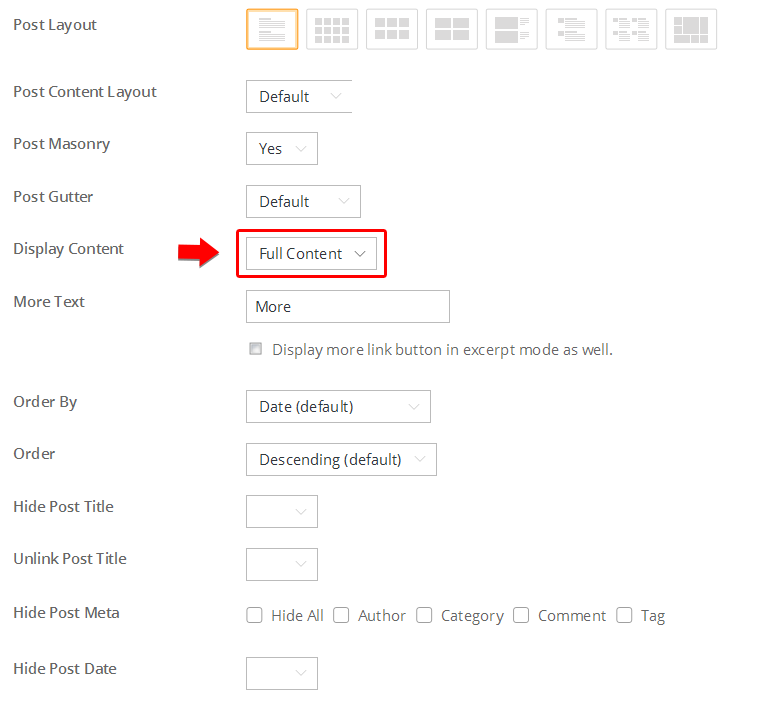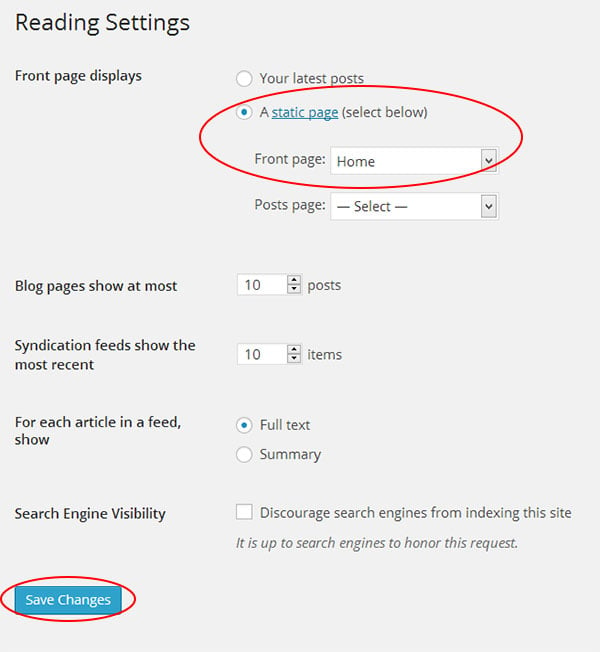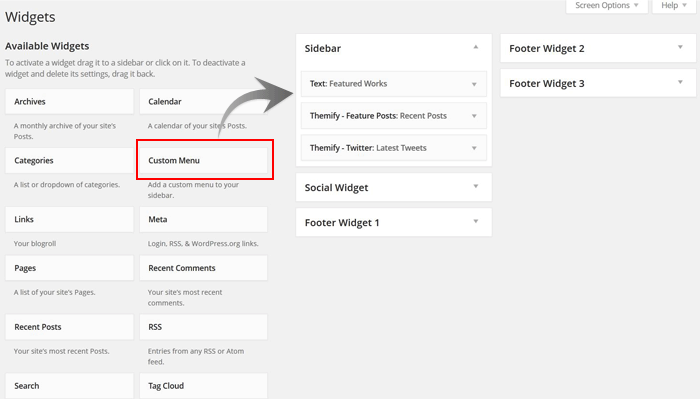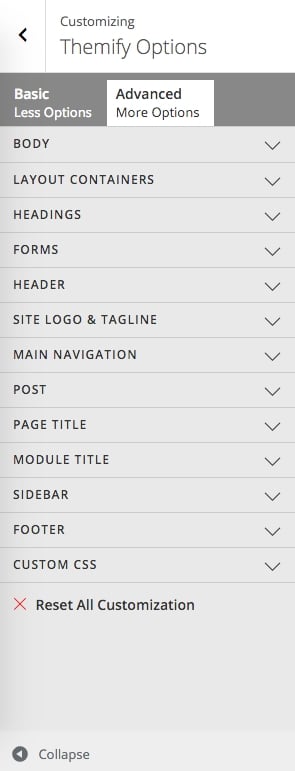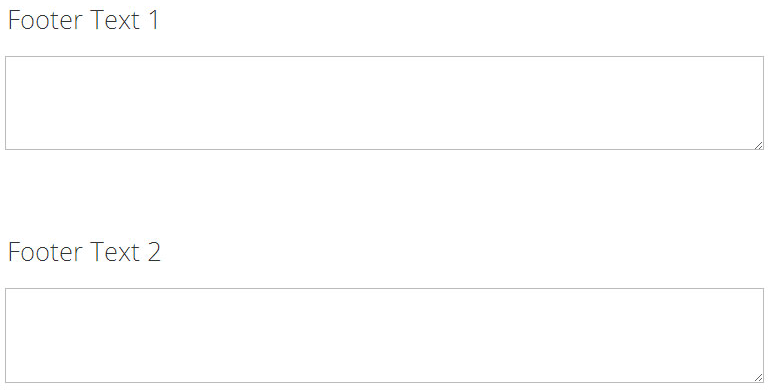Agency
Installing the Theme
To install themes with the WordPress theme uploader:
- Download the "theme.zip" file from the Member Area
- Note: some browsers (eg. Safari) auto extract zip files automatically. Right-click on the download link and select "Save Linked File As". This will allow you to download the theme as a zip file.
- Login to your site's WP Admin.
- Go to Appearance > Themes.
- Click on the "Add New" button, then click on the "Upload Theme" button
- Upload the theme.zip file (note: it is the theme.zip, not the theme-psd.zip that you just downloaded from the Member Area).
- Activate the theme
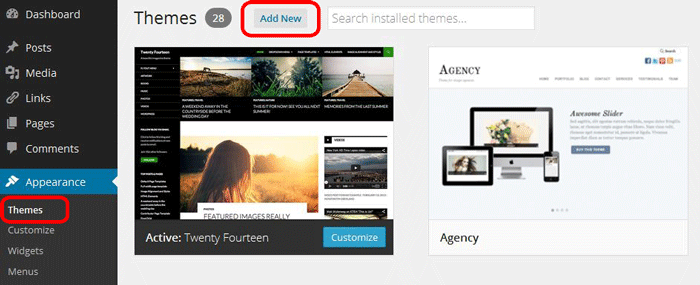
FYI: You can also install themes with FTP method. Read the Installing Themes tutorial for more info.
Demo Import
If you are starting a fresh site, importing the demo content will help you understand how the theme demo is built. The Demo Import feature will import the contents (posts, pages, comments, etc.), Themify panel settings, menus, and widgets setup from our demo to your site. You can erase the demo content afterward.
To import the demo setup:
- Go to WP Admin > Themify > Settings > Demo Import and click "Import Demo" button.
- Note that the featured images will be replaced with an image placeholder for copyright reasons.
To erase the demo setup:
- On the Demo Import tab, click on the "Erase Demo" button which will then remove the demo content.
FYI: If the Demo Import does not work on your site, you can use the WP Admin > Tools > Import tool to import the demo content manually.
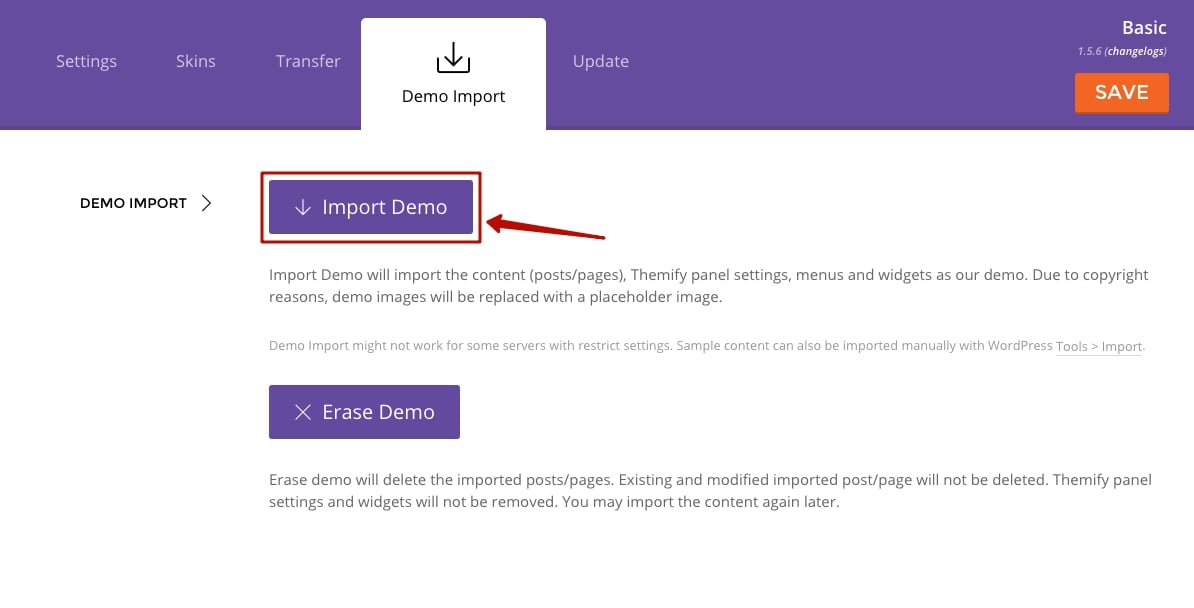
Site Logo & Tagline
To display a logo image instead of the site name text:
- Go to WP Admin > Appearance > Customize > Site Logo and Tagline.
- Under "Site Logo", select "Logo Image" radio button.
- Upload a logo image.
- Specify the logo image width and height.

You can also change website Tagline from here:
- Go to WP Admin > Appearance > Customize > Site Logo and Tagline.
- Scroll down and under "Site Tagline" select "Text" radio button.
- Enter your site Tagline.
- Click "Save & Publish".
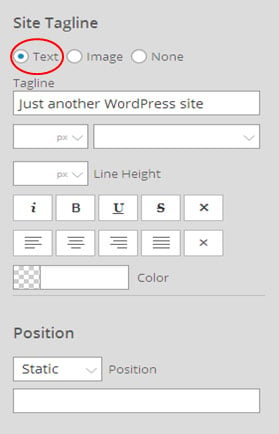
Main Navigation Menu
To create a custom navigation menu:
- Go to WP Admin > Appearance > Menus.
- Click on "create a new menu" to create a new menu (eg. Main Menu).
- Add the menu items from the left panels.
- To create a dropdown menu: drag the menu item towards the right (the item(s) will be indented).
- When you are done adding the menu items, click "Save Menu".
- To assign menu locations:
- Scroll down to the bottom where it says "Theme locations" and tick the menu location checkbox.
- Main Navigation = main menu on the header
- Footer Navigation = footer menu on the footer (Note: some themes might not have Footer Navigation).
TIPS: You can display menus on sidebar widgets, remove the main menu, create empty links, and lightbox links. Read Custom Menus for more detailed tutorial.
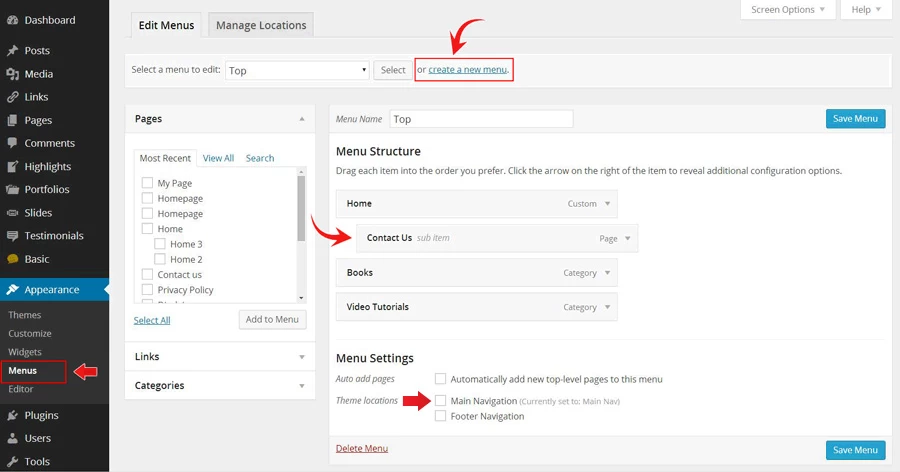
Setting Up the Social Links
Step 1) To set up the social media links:
- Go to WP Admin > Themify > Settings > Social Links tab.
- The theme comes with some pre-filled social links. Simply enter your social profile URL in the Link input field. For example, enter 'https://twitter.com/themify' for the Twitter link.
- You can choose to display either "Icon Font" or "Image".
- If "Icon Font" is selected, click on "Insert Icon" to select an icon (over 320+ icons available).
- If "Image" is selected, you can upload your own graphic icon by clicking on the Upload button.
- To add more links, click on the Add Link button at the bottom.
- To remove a link, click on the delete icon.
- To arrange the display order, drag and drop the link container.
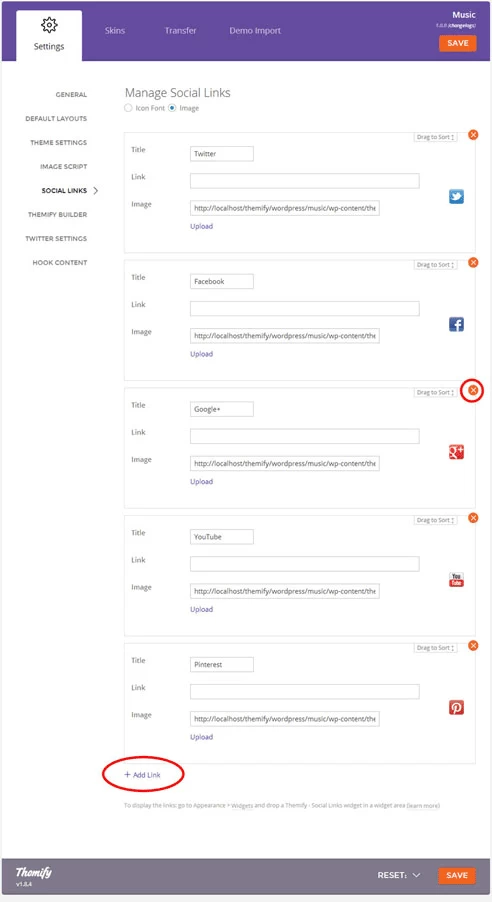
Step 2) Displaying the Social Links:
- Once you have the Social Links setup, go to WP Admin > Appearance > Widgets. Drag and drop the Themify - Social Links from the Available Widgets panel to the Social Widget panel.
- Optional: Customize Widget Title - such as "Follow Us". You can also "Show link name" and adjust icon size.
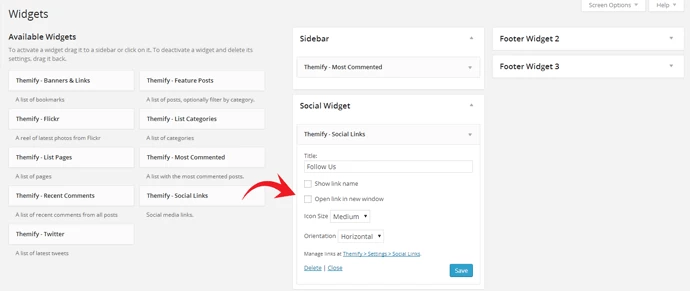
Hiding the RSS Icon
To hide the default RSS icon in the header:
- Go to WP Admin > Themify > Settings > Theme Settings.
- Under the "Exclude RSS Link", tick the checkbox that says "Check here to exclude RSS icon/button in the header".
Hiding the Search Form
To hide the default search form in the header:
- Go to WP Admin > Themify > Settings > Theme Settings.
- Under the "Exclude Search Form", tick the checkbox that says "Check here to exclude search form in the header".
Custom Homepage
Creating the homepage with Themify Builder
To create a custom Page as shown on our demo:
- Create a new Page (eg. Custom Homepage)
- View the page frontend
- On the top admin bar, select Themify Builder > Turn On Builder (view Builder documentation for more info)
- Expand the first row to full width column, then drop in a Builder - Highlight module, select the grid3 layout icon for the Highlight posts
- Then drop a Builder - Divider module below the Highlight module, set the divider color as you like
- On the next row, create 3-column grid (drag the column dividers left/right to merge or expand columns), then:
- In the first column: drop a Builder - Widget module, select Themify - Feature Post widget and the configure the widget options as you like
- In the second column: drop a Builder - Widget module, select Themify - Twitter and enter your Twitter ID in the options (note: you need to create a required access token from Twitter API in order to show the tweets)
- In the third column: drop a Builder - Text module and enter any text as you like. You can insert Heading tags (H1 - H6) and shortcodes as you like
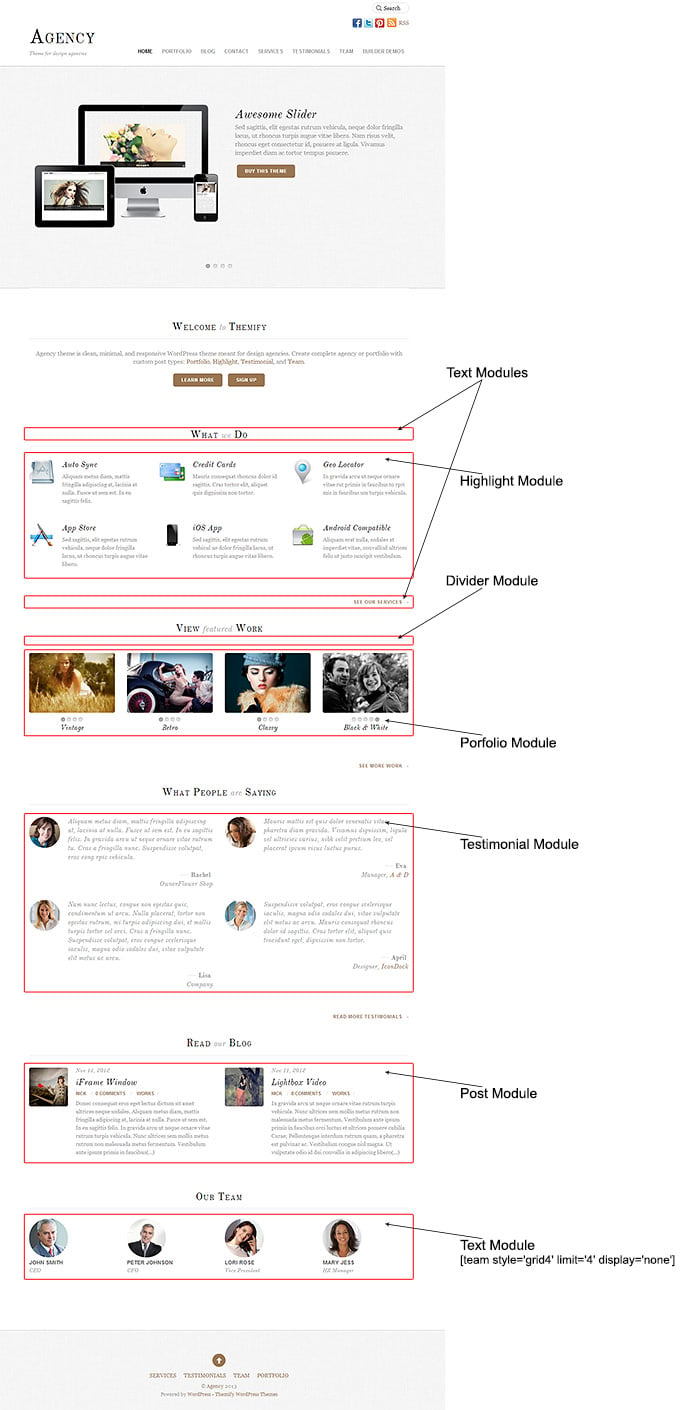
Set Custom Front Page
After you set the page as front page, the home slider and welcome message will appear. To set the front page:
- Go to wp-admin > Settings > Reading
- Select a static page under the "Front page displays"
- Then select "Custom Homepage" in the dropdown
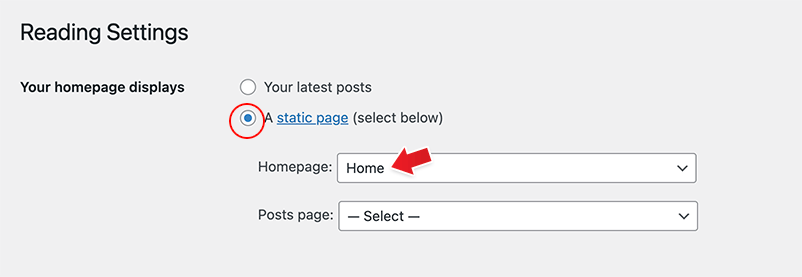
Welcome Message
To display a welcome text, go to Themify > Theme Settings and enter the html content in the Welcome Text box. You may also enter shortcodes in the welcome text box. Below is a sample welcome text in HTML format with two button shortcodes:
<h2>Welcome <em>to</em> Themify</h2> <p>Curabitur vel risus eros, sed eleifend arcu.</p> [button link="https://themify.me"]Learn More[/button] [button link="https://themify.me/themes"]Sign Up[/button]
Slider Post Type
Use the slider to highlight features or services your site. To show the slider on the front page, you need to add the Slider posts first.
To add Slider posts:
- Click on the "Add New" link under the Slider admin menu.
- Choose the layout option:
- default: display the feature image on left, title and content on the right
- image-only: display the feature image only (no title or content)
- content-only: display the content only (title and feature image will not be displayed)
- image-caption: display the title and content as overlay image caption
- Upload a featured image.
- If you want to display a video embed instead of a featured image, insert the Video URL in the custom panel.
- Image width and height is optional. If the field is empty, default image size will apply.
- Image link is optional.
Slider Options
To customize the slider transition effect, speed, etc., go to Themify > Theme Settings.
Portfolio Post Type
To add Portfolio posts:
- Click "Add New" under the Portfolios admin menu
- Enter the title and content
- Upload a Featured Image
- To display multiple images instead of a single featured image: click on the upload Media icon and upload the images as gallery (read this tutorial for more details on how to use gallery). Note: you don't need to insert the[gallery]
into the content. The theme will automatically get the gallery images and display it as a mini slider.
- You can categorize the Portfolio posts by adding new portfolio categories in the Portfolio Categories panel (eg. you can categorize them as: Illustration, Web, Photos, etc.)
To display the Portfolio posts
To display the Portfolio posts simply enter the shortcode in the post content box. You can configure the result by adding the parameters.
-
- = display Portfolio posts with default setting
-
- = display latest 3 Portfolio posts in grid4 layout, set image dimension to along post date
-
- = display latest (first) 8 Portfolio posts from Portfolio Category ID 13 in grid2 layout
- = if there are more than 8 posts, a page navigation will appear (note page_nav="yes")
-
- = display latest Portfolio posts from portfolio categories Web Design and Illustration, given that their text slugs are "web-design" and "illustration".
- = if there are more than 4 posts, a page navigation will appear (note page_nav="yes")
Available parameters:
- style= grid4, grid3, grid2, full
- you can also include additional CSS class(es) for your own custom styling (eg. style="classname")
- limit = number of post to query (eg. enter limit="4" will query 4 posts, enter -1 to query all posts)
- category = category ID number or text slug (default = all categories). To find category ID number or text slug: click on "Portfolio Category" link located under the Portfolio admin menu
- image = show featured image or not (yes, no, default = yes)
- image_w = post image width
- image_h = post image height
- title = show post title (yes, no, default = yes)
- display = display whether content, excerpt or none (content, excerpt, none, default = none)
- post_meta = display post category meta (yes, no, default = no)
- post_date = display post date (yes, no, default = no)
- more_link = display a custom more link after the posts
- more_text = text that will appear in more_link
- page_nav = display page navigation if there are more posts (yes, no, default = no)
Portfolio Layout Options
To set the layouts of portfolio index and portfolio single page, go to Themify > Settings > Default Layouts.
- Portfolio Gallery Slider = applies to the Portfolio posts that have multiple images uploaded via Media panel (gallery)
- Default Index Portfolio Layout = applies to the Portfolio category pages
- Default Single Portfolio Layout = applies to the Portfolio single post page
Changing the portfolio permalink slug
By default, your portfolio single views will look like http://example.com/project/some-illustration/. If you want to change the "project" section, follow these steps that show how to change it into "work":
- create a file named custom-functions in Agency theme folder
- open it and paste:
<?php function themify_theme_portfolio_rewrite($slug){ return 'work'; } add_filter('themify_portfolio_rewrite', 'themify_theme_portfolio_rewrite'); ?> - save the file and upload it to your server
- login to the WP Admin in your site
- go to Settings / Permalinks and click Save Changes
Your URLs for single portfolios will now look like http://example.com/work/some-illustration/.
Team Post Type
To add Team posts:
- Click "Add New" under the Teams admin menu
- Enter the title and content
- Upload a Featured Image (team member picture)
- Enter the Team Member Title
- You can categorize the Team posts by adding new categories in the Team Categories panel (eg. you can categorize them as: Executive, General, HR, etc.)
Displaying Team Posts:
To display the Team posts simply enter the shortcode in the post/page content box. You can configure the result by adding various parameters, such as the following examples:
- [team]
- = display Team posts with default settings.
- [team style="grid3" limit="3" post_date="yes" image_w="100" image_h="100"]
- = display latest 3 Team posts in grid4 layout, set image dimension to along post date
- [team style="grid2" limit="8" image_w="140" image_h="140" unlink_title="yes" unlink_image="yes"]
- = display latest (first) 8 Team posts in grid2 layout
- = it will unlink post title and image
- [team category="14" style="grid2" limit="10" use_original_dimensions="yes" unlink_title="yes" unlink_image="yes"]
- = display the category 14 of Team entries up to a limit of 10 posts and using original dimensions for those entries that have width and height specified in Custom Panel.
- = it will unlink post title and image
Available parameters:
- style = grid4, grid3, grid2, grid2-thumb, list-post
- limit = number of post to query (eg. enter limit="4" will query 4 posts, enter -1 to query all posts)
- category = category ID number or text slug (default = all categories). To find category ID number or text slug: click on "Team Category" link located under the Team admin menu
- image = show featured image or not (yes, no, default = yes)
- image_w = post image width
- image_h = post image height
- title = show post title (yes, no, default = yes)
- display = display whether content, excerpt or none (content, excerpt, none, default = none)
- more_link = display a custom more link after the posts
- more_text = text that will appear in more_link
- use_original_dimensions = use image width & height specified in the Team entry Custom Panel
- unlink_image = remove the link on featured image (yes, no, default=no)
- unlink_title = remove the link on the post title (yes, no, default=no)
Testimonial Post Type
To add Testimonial posts:
- Click "Add New" under the Testimonial admin menu
- Enter the title and content
- Upload a Featured Image (the testimonial author picture)
- Enter:
- Testimonial Author Name
- Testimonial Author Link (will link to Testimonial Author Company)
- Testimonial Author Company
- Testimonial Author Position
- You can categorize the Testimonial posts by adding new categories in the Testimonial Categories panel (eg. you can categorize them as: Testimonial A, Testimonial B, etc.)
To display the Testimonial posts
To display the Testimonial posts simply enter the shortcode in the post content box. You can configure the result by adding the parameters.
- [testimonial]
- = display Testimonial posts with default setting
- [testimonial style="grid3" limit="3" image_w="80" image_h="80"]
- = display latest 3 Testimonial posts in grid3 layout and set image dimension to 80 x 80px
- [testimonial category="13" style="grid2" limit="8" page_nav="yes" image_w="80" image_h="80"]
- = display latest 8 Testimonial posts from Testimonial Category ID 13 in grid2 layout
- [testimonial category="client" style="grid2" limit="4"]
- = display latest Testimonial posts from 'client' (slug) category
Available parameters:
- style= grid4, grid3, grid2, full
- you can also include additional CSS class(es) for your own custom styling (eg. style="classname")
- limit = number of post to query (eg. enter limit="4" will query 4 posts, enter -1 to query all posts)
- category = category ID number or text slug (default = all categories). To find category ID number or text slug: click on "Testimonial Category" link located under the Testimonial admin menu
- image = show featured image or not (yes, no, default = yes)
- image_w = post image width
- image_h = post image height
- title = show post title (yes, no)
- display = display whether content, excerpt or none
- more_link = display a custom more link after the posts
- more_text = text that will appear in more_link
Highlight Post Type
Highlight post type consists a short paragraph of text with an image icon and heading. It can be used to display a list of services, product feature list, etc.
To add Highlight posts:
- Click "Add New" under the Highlight admin menu
- Enter the title and content
- Upload a Featured Image (the testimonial author picture)
- Enter:
- Highlight Author Name
- Highlight Author Link (will link to Highlight Author Company)
- Highlight Author Company
- Highlight Author Position
- You can categorize the Highlight posts by adding new categories in the Highlight Categories panel (eg. you can categorize them as: Highlight A, Highlight B, etc.)
To display the Highlight posts
To display the Highlight posts simply enter the shortcode in the post content box. You can configure the result by adding the parameters.
- [highlight]
- = display Highlight posts with default setting
- [highlight style="grid3" limit="3" image_w="80" image_h="80"]
- = display latest 3 Highlight posts in grid3 layout and set image dimension to 80 x 80px
- [highlight category="13" style="grid2" limit="8" page_nav="yes" image_w="80" image_h="80"]
- = display latest 8 Highlight posts from Highlight Category ID 13 in grid2 layout
- [highlight category="features" style="grid2" limit="4"]
- = display latest Highlight posts from 'features' (slug) category
Available parameters:
- style= grid4, grid3, grid2, full
- you can also include additional CSS class(es) for your own custom styling (eg. style="classname")
- limit = number of post to query (eg. enter limit="4" will query 4 posts, enter -1 to query all posts)
- category = category ID number or text slug (default = all categories). To find category ID number or text slug: click on "Highlight Category" link located under the Highlight admin menu
- image = show featured image or not (yes, no, default = yes)
- image_w = post image width
- image_h = post image height
- title = show post title (yes, no)
- display = display whether content, excerpt or none
- more_link = display a custom more link after the posts
- more_text = text that will appear in more_link
Displaying Blog Posts
To display regular blog posts, use the existing list_posts shortcode: [list_posts image="yes" style="grid4"]. For more details on list_posts, please refer to the documentation here.
Sub-heading Styling
Our theme comes a fancy pre-designed H2 sub-heading. To display a fancy sub heading: select Heading 2 format. To set italic font style, select the text and then click on the 'italic' icon. If you don't see the Heading dropdown menu on your editor, click on the "Show/Hide Kitchen Sink" icon.
Creating a Custom Front Page
Having the ability to display the custom post types with shortcodes gives you a full control what to appear on the page. For example, you can create a page with whatever post types you want to appear and set it as front page (home page). To do so:
- create a new Page (eg. Home)
- in the Page Custom Panel, select Yes => Hide Page Title
- enter the shortcodes like below
- then go to WP Admin > Settings > Reading and select 'Home' as your Front page.
<h2>What we Do</h2> [highlight style="grid3" limit="6" more_text="See our services →" more_link="https://themify.org/agency/services/"] <h2>View featured Work</h2> <h2>What People are Saying</h2> [testimonial style="grid2" limit="4" more_text="Read more testimonials →" more_link="https://themify.org/agency/testimonials/"] <h2>Read our Blog</h2> [list_posts style="grid2-thumb" limit="2" image="yes" image_w="80" image_h="80" display="excerpt" post_meta="yes" post_date="yes"] <h2>Our Team</h2> [team style="grid4" limit="4" display="none"]
Running Shortcodes in Sidebars
All shortcodes can also be inserted into sidebars using the Text widget. To run a shortcode in the widget:
- go to Appearance > Widgets
- drag and drop a Text widget to a sidebar
- then enter the shortcode
Lightbox Media
To link the featured image with a lightbox popup such as image zoom, video or an iframe window, enter the URL in the Lightbox Link field under the Themify Custom Panel. The Themify Custom Panel can be found in the post edit page.
- Sample image: https://themify.org/pinboard/files/2012/06/133618178.jpg
- Sample video: http://youtu.be/Abjx1JJO1i8
- Sample iframe: https://themify.me?iframe=true&width=100%&height=100% (you need to add
?iframe=trueat the end of the URL)
Inserting Gallery to Posts or Pages
The gallery can be inserted in any post or page. To insert a gallery, click on "Add Media" button
It will open a lightbox for you to create and insert gallery. Read this tutorial for more details on how to use WordPress Gallery.
Recommended Plugin: Post Types Order Plugin
By default, the posts are sorted by publish date. Post Types Order plugin allows you to sort the post order with drag and drop. After you activate the plugin, you will see a "Re-Order" menu link under each post type. This plugin is great for ordering your portfolio or highlight posts.
Setting Default Post and Page Layouts
Generally, the theme works out of the box. All the sidebar options and image dimensions are pre-defined in the theme. If you need to change the default sidebar options, featured image dimensions, content/except display, post meta, etc., it can be done in the WP Admin > Themify > Settings > Default Layouts.
There are three default layout options under Themify > Settings > Default Layouts:
- Archive Sidebar Option: refers to the default home page, category, search, archive, tag pages, etc.
- Default Post Layout: is the post page direct URL (also known as "Single Post").
- Note: Some themes may only have 4 layouts.
- Default Static Page Layout: is the static page.
FYI: Read Default Layouts documentation for more info.
Creating a Blog Page
To create a blog page:
- First, create a new Page (go to WP Admin > Pages > Add New), name it "Blog" or any page title as you want.
- View the page on the frontend, click "Turn On Builder".
- Drop in a Post module and configure the options as you like.
Setting a Custom Front Page
You can set any page as the front (home) page. This means you can use the Builder to design the page and assign it as the front page. To set the Front Page:
- Go to WP Admin > Settings > Reading.
- On the Front page displays, select the "A static page (select below)" option and then select a "Front page".
- Leave the "Posts page" default. If you want to create a custom Blog page, read this tutorial instead of setting the "Posts page".
Adding Widgets
To add widgets to widgetized areas (eg. sidebar and footer widgets):
- Go to WP Admin > Appearance > Widgets.
- The big panel on the left side shows all available widgets. The small panels on the right are the widgetized areas.
- To add a widget: drag and drop the widget from the left panel to the right panel.
- To remove the widget: drag the widget back to the left panel (Available Widgets panel). If you want to keep the widget setting for future use, drag it to the Inactive Widgets instead of the Available Widgets panel. It will save your widget settings. To retrieve the widget, drag the widget from Inactive Widgets panel instead of the Available Widgets panel.
TIPS: You can also add widgets in Appearance > Customize panel.
Theme Skins
To apply pre-designed color skins:
- Go to WP Admin > Themify > Skins, select a skin by clicking on the thumbnail and click Save.
Styling The Theme
To style the theme frontend appearance:
- Go to WP Admin > Appearance > Customize.
- It will take you to the Customize panel with live preview where you can style the appearance of the theme design (ie. color, background, font, spacing, border, etc.).
FYI: Refer to Customize documentation for more info.
Footer Widgets
- To set the Footer Widget column layout, go to WP Admin > Themify > Settings > Theme Settings.
- To drop the widgets in the Footer Widgets, go to WP Admin > Appearance > Widgets.
Footer Text
To replace the footer credit links:
- Go to WP Admin > Themify > Settings > Theme Settings and enter the footer text.
- HTML tags are allowed in the Footer Text.
- To have empty footer text, tick the hide footer text checkbox.
